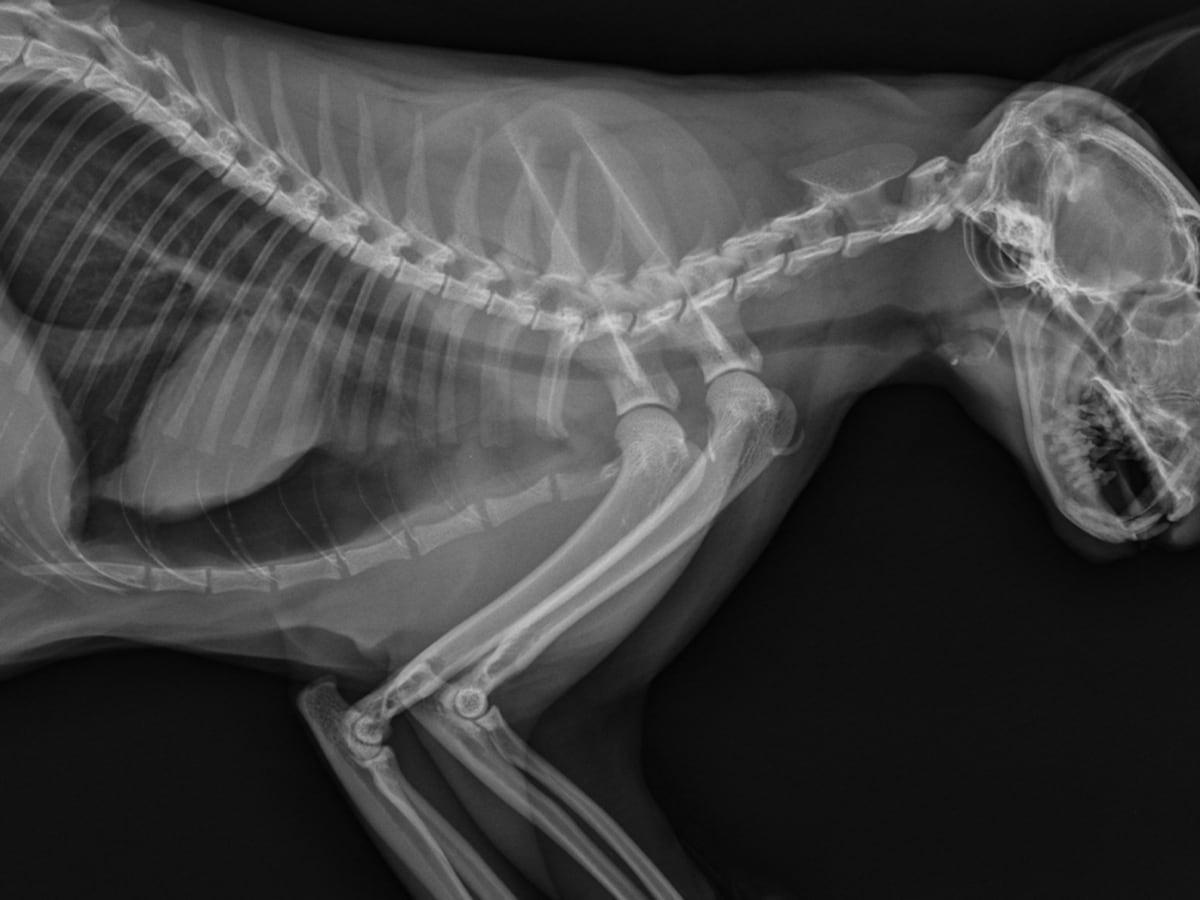The way cats can twist and fold themselves through tiny spaces is always fascinating to watch. They’re so flexible and agile that it’s difficult to believe they have bones under that fur coat.
The truth is that your cat’s bone structure is responsible for their magical body movements. Spot Pet Insurance details your cat’s bone structure and what it means for their health.
How many bones does my cat have?
Cats have a specialized skeleton made up of around 230 bones. This is much fewer than dogs such as the Great Dane, who has up to 321 bones. A cat’s skeleton is designed to give them flexibility and strength. Their joints and muscles work together to help your cats move gracefully. A cat’s bony framework has major and minor components, but they all support each other.
Spinal column
A cat’s spinal column consists of about 30 spinal vertebrae. They’re put into five categories according to their location: cervical, thoracic, lumbar, sacral, and caudal.
The flexible connection between your cat’s spinal bones allows them to twist in magnificent ways. It also contributes to their agility.
A cat’s vertebral column extends from the base of their skull to the tip of their tail. The number of bones in each segment of your cat’s spinal column are:
Cervical — 7 bones
Thoracic — 13 bones
Lumbar — 7 bones
Sacral — 3 fused bones
Caudal — 18 to 23 bones
Skull
If you ever see a cat skull, it looks like one giant hollow bone. However, if you look closely, you’ll see fibrous joints called sutures that hold several bones together. Interestingly, a cat’s skull contains 29 bones.
Your cat’s skull covers their brain and forms their facial structure. It’s designed to suit their life as predators. Therefore, their jaws are strong enough to catch and devour prey. They also have large eye sockets to accommodate their highly adapted eyes for clear vision.
Ribs
Cats have 13 pairs of ribs corresponding to the number of thoracic vertebrae. Each rib is attached to the corresponding thoracic vertebrae behind. In the center of your cat’s chest, they have a sternum comprising nine bones.
The upper ribs attach to the sternum. On the other hand, the lower ribs either fuse with cartilage to form a rim or simply float in their back.
The bones, cartilage, and muscles that make up your cat’s ribs are highly compressible. Therefore, they allow your cats to squeeze through narrow spaces.
Forelimbs
Cats have major and minor bones in their forelimbs. The three major bones in a cat’s foreleg are the humerus, ulna, and radius.
They have smaller bones called metacarpals. Cats have five toes in their paws that contain three tiny bones each.
Hindlimbs
Like their forelimbs, cats also have three major bones in their hind legs — femur, tibia, and fibula. Toward the distal portion of your cat’s legs, they also have smaller bones called metatarsals.
However, their hindlimb paws are different from their forelimbs because they contain only four toes. Their hind paws are shaped such that their heels don’t touch the floor, hence the iconic catwalk.
Clavicles
Just like humans, cats have clavicles (collarbones). Although they’re the same type of bone, there’s a significant difference between a cat’s collar bone and a human being’s.
Cats don’t have their clavicles connected with their shoulder blades (scapula). This allows them to have a greater degree of movement than humans. It’s also why they can squeeze themselves through tiny spaces.
Tail
Although a cat’s tail is technically an extension of the vertebral column, it has a separate function. This chain of 18-23 caudal bones adds to a cat’s incredible balance. They use it to counterbalance their weight as they walk across high narrow beams.
Do all cats have the same number of bones?
No, the number of bones a cat has varies between 230 to 245. Their gender and breed can determine the total number of bones they have.
A cat’s tail can have between 18 to 24 bones. Therefore, cats without tails, such as the Manx will generally have fewer bones than other breeds. On the other hand, cats with long tails may have more bones.
Male cats have an extra bone in their penis. This means that they will have at least one more bone than their female counterparts, even within the same breed.
Specific genetic mutations can give your cat more or fewer bones than the average. For instance, polydactyl is when a cat has an extra digit. This increases the total number of bones in their body — often seen in the Hemingway cats.
What are the similarities between cat and human bones?
Cat bones and human bones have the same basic structure. They have a strong outer layer that contains minerals. This outer shell is responsible for bone strength.
Underneath this tough exterior is the bone marrow. It contains the cells that produce red and white blood cells. The red blood cells help move oxygen around your body, while the white blood cells help fight off infections. They serve these same functions in both cats and humans.
What are the differences between a cat and human bones?
Humans are significantly larger than cats, but they have fewer bones. Cats have about 230 bones while humans are behind with 209.
Your cats’ tail gives them additional bones that you don’t have. Depending on the breed, that’s 18 to 23 bones extra. They also have more thoracic and lumbar vertebral bones than you.
Cats and humans differ in how their bones and muscles are aligned. For instance, your clavicle connects your shoulder blade to your chest, but this isn’t so for cats. A cat’s clavicle doesn’t have a bony connection with their scapula. This is why, unlike humans, cats can squeeze through small spaces.
Can cats break their bones?
Yes, they can.
Cats might look indestructible as they bend out of tight corners, but they’re not. Cats can break their bones just like any other animal. If they land the wrong way, they might have a serious injury. Your cat’s legs are the most susceptible to injury, but they can break any bone in their body.
Here are some signs that your cat might have broken a bone:
Swelling
Unusual gait
Unusual behavior
Crying or meowing
Restricted movement
Only your vet can determine if your cat truly has a fracture. Therefore, if you see these signs, a vet appointment might be due.
They’ll assess the extent of your cat’s injury and determine how best to treat them. Sometimes, a cat can heal from a fracture by themselves. Other times, surgery might be necessary.
Final thoughts
Cats are a marvel of nature. The way they move and jump is enthralling. It’s all made possible thanks to their skeletal structure. With about 230 connected bones, cats have an incredible freedom of movement.
Cats have major skeletal structures such as their vertebral column, skull, forelimbs, hindlimbs, and ribs. Other minor bony structures include the clavicle and tail.
Humans and cats have the same basic bone structure. However, cats have way more bones than humans. They have extra skull and vertebral bones. Furthermore, the connection between your cat’s bones and muscles isn’t the same as yours.
Cats might symbolize flexibility, but they can get fractures too. If you notice changes in your cat’s gait or swelling, you should see a vet. They’ll nurse your feline friend back to health.
Keeping your pet safe is a priority, and you can get everything you need from the Spot Pet Insurance blog.

With 10 years of experience as a pet parent, I aim to empower pet owners with insights into pet insurance and maintaining their pet's well-being. I aspire to be a trusted source, combining knowledge with a commitment to the welfare of our beloved pets.
Cat Anatomy and Physiology | Colorado State University Extension
Why Some Animals Still Have a Penis Bone | Science X Daily
How Many Bones Does a Dog Have? | Cuteness
What to Do When Your Cat Has a Broken Bone | South Seattle Veterinary Hospital












